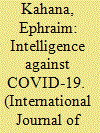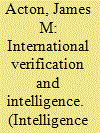| Srl | Item |
| 1 |
ID:
119419


|
|
|
|
|
| Publication |
2013.
|
| Summary/Abstract |
A decade ago, the literature on the relationship between ethics and intelligence was very limited. However, the post-9/11 (11 September 2011) intelligence and security environment, in which national intelligence agencies have been required to play front line "war on terror" roles, has heightened the importance of debate about, and an informed understanding of, the ethics-intelligence relationship. But any such debate requires a framework. Consequently, over recent years, a literature on ethics and intelligence has begun to develop. Our aim is to contribute to this movement, add further flesh to the framework, and encourage others to participate in the debate.
|
|
|
|
|
|
|
|
|
|
|
|
|
|
|
|
| 2 |
ID:
177926


|
|
|
| 3 |
ID:
131603


|
|
|
|
|
| Publication |
2014.
|
| Summary/Abstract |
Both national intelligence agencies (NIAs) and international verification organizations (IVOs) attempt to assess compliance with arms control treaties. Their strengths and weaknesses are complementary. Because IVOs are seen as legitimate, they are able to conduct on-site inspections to verify declared activities and to confirm or disprove allegations of clandestine cheating. NIAs are more flexible and have a greater ability to uncover preliminary evidence of clandestine activities on which further investigations can be based. Such investigations require NIAs to share intelligence with IVOs. While this kind of intelligence sharing is generally permitted by arms control agreements, it is controversial. Nonetheless, it appears to have become more common in recent years, particularly during the International Atomic Energy Agency's investigation of Iran's nuclear program. While intelligence sharing creates risks for both IVOs and NIAs, it is ultimately critical to the effective verification of arms control agreements and steps can and should be taken to ensure it becomes more common and less controversial.
|
|
|
|
|
|
|
|
|
|
|
|
|
|
|
|
| 4 |
ID:
113402


|
|
|
|
|
| Publication |
2012.
|
| Summary/Abstract |
Since the events of 9/11 the terms 'threat' and 'risk' have entered the daily lexicon to a greater extent than ever before. News media report on changes to national threat assessments, commenting when the threat level rises from 'Moderate' to 'Substantial', in the case of the United Kingdom. The British government recently released a document that provided details of the issues that pose the highest risk to the national infrastructure. All of these are based, so we are told, on the work of the national intelligence agencies. But what are these indicators actually telling us and what is the relationship between threat assessments and risk assessments? These are both important questions because important decisions are made as a result of changes in these assessments. National defence and security planning is based upon perceived threats and risks. An entire risk management industry has grown up in the business world that covers everything from health and safety to financial risk. It is not only governments and businesses that base decisions on these indicators, but individuals as well. Tourists planning holidays in Europe were alarmed when the British, French and German governments increased their threat levels in response to intelligence that suggested that an attack against tourist sites in their respective capitals was imminent. Some will have changed their plans and travelled elsewhere, to the detriment of the tourist industry, while others will have chosen to defy the terrorists and travel anyway - potentially placing themselves in harm's way. With so much at stake, both nationally and individually, it is therefore important that we understand the difference between a 'threat' and a 'risk' and, as scholars of intelligence, the role that intelligence plays in assessing them.
|
|
|
|
|
|
|
|
|
|
|
|
|
|
|
|